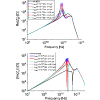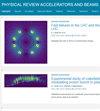Terahertz scale microbunching instability driven by high resistivity nonevaporable getter coating resistive-wall impedance
IF 1.8
3区 物理与天体物理
Q3 PHYSICS, NUCLEAR
Physical Review Accelerators and Beams
Pub Date : 2024-03-06
DOI:10.1103/physrevaccelbeams.27.034401
引用次数: 0
Abstract
Nonevaporable getter (NEG) coating is widely required in the new generation of light sources and circular colliders for small vacuum pipes to improve the vacuum level, which, however, also enhances the high-frequency resistive-wall impedance and often generates a resonator-like peak in the terahertz frequency region. In this paper, we will use the parameters of the planned Hefei Advanced Light Facility storage ring to study the impact of NEG-coating resistive-wall impedance on the longitudinal microwave instability via particle tracking simulation. Using different NEG-coating parameters (resistivity and thickness) as examples, we find that the impedance with a narrow and strong peak in the terahertz frequency region can cause terahertz scale microbunching instability, which has a low instability threshold current and contributes to a large energy spread widening above the threshold. In order to obtain a convergent simulation of the beam dynamics, one must properly resolve such a peak. The coating with a lower resistivity has a less sharp peak in its impedance spectrum, and there is a regime that it is helpful to suppress the terahertz scale microbunching instability and in return contributes to a higher instability threshold current.

高电阻率非蒸发获取器涂层电阻壁阻抗驱动的太赫兹尺度微束不稳定性
在新一代光源和环形e+e对撞机中,为提高真空度,普遍需要在小型真空管道上进行非气相获取器(NEG)镀膜,但这也会增强高频阻壁阻抗,并经常在太赫兹频率区产生类似谐振的峰值。在本文中,我们将利用规划中的合肥先进光设施存储环的参数,通过粒子跟踪模拟来研究 NEG 涂层电阻壁阻抗对纵向微波不稳定性的影响。以不同的 NEG 涂层参数(电阻率和厚度)为例,我们发现在太赫兹频率区具有窄而强峰值的阻抗会引起太赫兹尺度的微束不稳定性,该不稳定性阈值电流较低,并导致阈值以上的能量扩散扩大。为了获得收敛的光束动力学模拟,我们必须正确解析这样的峰值。电阻率较低的涂层在其阻抗谱中的峰值不那么尖锐,它有助于抑制太赫兹尺度的微冲不稳定性,反过来又有助于提高不稳定性阈值电流。
本文章由计算机程序翻译,如有差异,请以英文原文为准。
求助全文
约1分钟内获得全文
求助全文
来源期刊

Physical Review Accelerators and Beams
Physics and Astronomy-Surfaces and Interfaces
CiteScore
3.90
自引率
23.50%
发文量
158
审稿时长
23 weeks
期刊介绍:
Physical Review Special Topics - Accelerators and Beams (PRST-AB) is a peer-reviewed, purely electronic journal, distributed without charge to readers and funded by sponsors from national and international laboratories and other partners. The articles are published by the American Physical Society under the terms of the Creative Commons Attribution 3.0 License.
It covers the full range of accelerator science and technology; subsystem and component technologies; beam dynamics; accelerator applications; and design, operation, and improvement of accelerators used in science and industry. This includes accelerators for high-energy and nuclear physics, synchrotron-radiation production, spallation neutron sources, medical therapy, and intense-beam applications.
 求助内容:
求助内容: 应助结果提醒方式:
应助结果提醒方式:


